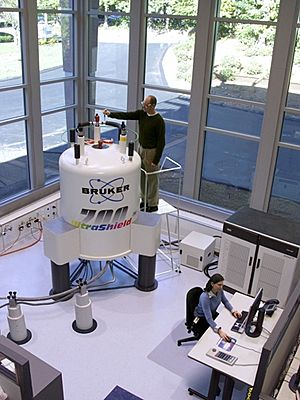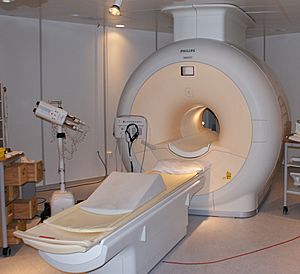Nuclear magnetic resonance facts for kids
Nuclear magnetic resonance (NMR) is the physical phenomenon in which magnetic nuclei in a magnetic field absorb, then re-emit electromagnetic radiation. This energy is of a specific resonance frequency that depends on the magnetic field strength, and the magnetic properties of the isotopes of the atoms. Many scientific techniques exploit the NMR phenomena to study molecular physics, crystals and non crystalline materials through NMR spectroscopy.
NMR is also used for advanced medical imaging techniques, for example, magnetic resonance imaging (MRI).
A key idea of NMR is that the resonance frequency of a particular substance is directly proportional to the strength of the applied magnetic field. This resonance is used in imaging techniques. If a sample is placed in a non-uniform magnetic field then the resonance frequencies of the sample's nuclei depend on where in the field they are located. Scientists try to use the highest possible magnetic fields to get the best image quality.
The principle of NMR usually involves two sequential steps:
- The alignment (polarization) of the magnetic nuclear spins in an applied, constant magnetic field H0.
- An electro-magnetic, usually radio frequency (RF), pulse causes a small shift of this alignment of the nuclear spins. The pulse frequency is chosen based on the static magnetic field (H0) and the nuclei being measured.
NMR is used in low-field NMR, NMR spectroscopy and MRI in the Earth's magnetic field (referred to as Earth's field NMR), and in several types of magnetometers.
History
Nuclear magnetic resonance was first described and measured in molecular beams by Isidor Rabi in 1938. In 1944, Rabi was awarded the Nobel Prize in Physics for this work. In 1946, Felix Bloch and Edward Mills Purcell expanded the technique for use on liquids and solids. They shared the Nobel Prize in Physics in 1952 for this discovery.
Purcell had worked on the development of radar during World War II at the Massachusetts Institute of Technology's Radiation Laboratory. His work during that project on the production and detection of radio frequency power and on the absorption of such RF power by matter laid the background for Rabi's discovery of NMR.
Rabi, Bloch, and Purcell noticed that magnetic nuclei, like 1H and 31P, could absorb RF energy when placed in a magnetic field of a strength specific to the identity of the nuclei. When this absorption occurs, the nucleus is described as being in resonance. Different atomic nuclei within a molecule resonate at different (radio) frequencies for the same magnetic field strength. The observation of such magnetic resonance frequencies of the nuclei present in a molecule allows any trained user to discover essential, chemical and structural information about the molecule.
After World War II, the development of NMR as a technique in analytical chemistry and biochemistry happened at the same time as the development of electromagnetic technology and advanced electronics and their introduction into civilian use. In the 1960s, William Lipscomb was a pioneer in using NMR to study chemical structures. He worked out how to look at NMR data to tell what atoms are connected together in a molecule. This is called chemical shift.
Images for kids
-
An intuitive model. Nuclei with spin have magnetic moments (spin magnetic moments). By itself, there is no energetic difference for any particular orientation of the nuclear magnet (only one energy state, on the left), but in an external magnetic field there is a high-energy state and a low-energy state depending on the relative orientation of the magnet to the external field, and in thermal equilibrium, the low-energy orientation is preferred. The average orientation of the magnetic moment will precess around the field. The external field can be supplied by a large magnet and also by other nuclei in the vicinity.
-
900 MHz, 21.2 T NMR Magnet at HWB-NMR, Birmingham, UK
See also
 In Spanish: Resonancia magnética nuclear para niños
In Spanish: Resonancia magnética nuclear para niños







